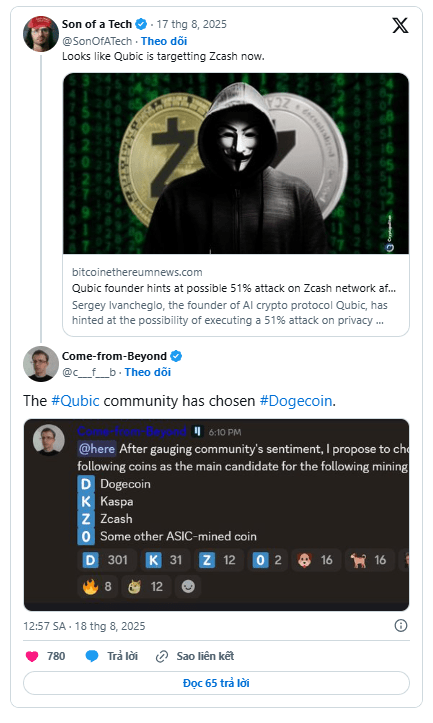The community behind Qubic, a blockchain project focused on AI, voted to target Dogecoin with the next 51% attack, just days after gaining control of a majority of the Monero network.
Qubic's founder, Sergey Ivancheglo, known in the cryptocurrency world as Come-from-Beyond, asked the project's community which ASIC-supported blockchain using proof-of-work mechanism would be the next one.
The options include Dogecoin, Kaspa, and Zcash. In a post on Sunday X, Ivancheglo confirmed the results: "The Qubic community has chosen Dogecoin."
Dogecoin Wins in Qubic Vote with Over 300 Supporters from the Community
Dogecoin, with a market capitalization of over $35 billion, received over 300 votes, surpassing the total votes of its competitors. Last week, Qubic shook the cryptocurrency industry by announcing it had gained control of a majority of Monero's hashrate.

Their mining team successfully restructured six blocks after a month of fighting with Monero miners. At the time of writing, this team has a performance of about 2.32 GH/s, becoming the strongest team in the network, according to MiningPoolStats.
After taking over, Qubic emphasized that Monero's core features, including privacy and transaction speed, remain intact, but added that their "ultimate goal" is for Monero's security to ultimately be provided by Qubic miners.
The attack forced Kraken to temporarily halt Monero withdrawals, citing "potential risks to the integrity of the network."
Withdrawals and transactions remain unaffected, while deposits are expected to resume once the exchange deems the network stable.
When asked about the reason behind the attack, Ivancheglo wrote on X that: "A lot of electricity has been burned for useless #PoW, we need that electricity for #AI."
“These words may be difficult to understand, and I cannot disclose more at this time, but in the future, they will have an effect,” he added.

While Qubic stated that this event proves they have gained control of the entire network, Monero developers disagreed.
Luke Parker, the lead developer at SeraiDEX, argues that the reorganization of six blocks does not definitively prove a successful 51% attack, but only shows that "the adversary with a large hash rate got lucky."
Others are not so dismissive. Zhong Chenming, co-founder of the cybersecurity company SlowMist, stated that the attack "appears to have succeeded," while warning that theoretically, the Qubic team could now rewrite the blockchain and censor all transactions.
The confrontation began in late June when Qubic announced they were redirecting the proof-of-work model, typically used for AI-related tasks, to mine Monero.
XMR mined will fund the acquisition and burning of Qubic tokens, creating a direct economic incentive to subdue the network.
Implications for Proof-of-Work
Qubic's expansion plan has raised new concerns about cryptocurrencies using proof-of-work mechanisms. By targeting well-known networks like Dogecoin, the project is challenging the resilience of some of the oldest blockchains in the industry.
A 51% attack allows a single entity to control the majority of the network's mining power, enabling double spending and block reorganization.
While the significantly larger scale of Dogecoin compared to Monero presents a greater challenge, the Qubic community's voting clearly indicates an intention to experiment.
With Dogecoin's prominence as the leading memecoin and one of the top 10 digital assets by market capitalization, any disruption could send shockwaves throughout the cryptocurrency market.



